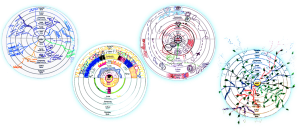Shae. Education in the Western World needs some serious updating. It is still designed around the linear mechanistic thinking of the Industrial Era. This can generate a relentless linear pressure, causing a lot of stress for students. Michael Alhadeff-Jones explains that as it currently stands, Western education can be damaging to young peoples’ capacity to fully develop cognitively, due to linear temporalities and mechanistic approaches. Perhaps this is why school refusal rates are skyrocketing. I know they are in Australia. An understanding of deep complexity, including that we are complex beings and are connected in so many ways, might be useful for assisting young people to know that they are part of a broader dynamic of complexity. In my teaching experience, it relieves the relentless pressure of mechanistic linearity.
The aim of Complexity Patterning is to build students’ capacity for conscious relationality, by tuning consciousness to the broad and dynamic patterning of human embeddedness in the world around us. The Complexity Patterning design and educational strategy has proven to be a way to expand the range of information students are conscious of. Tuning students’ consciousness to the complexity they are, and are a part of, is a useful way forward in transformational education. There is a dynamic and indeterminate quality in complex phenomena as well, and humans certainly are complex phenomena. Patterns are useful here as they can express this paradox of constancy and dynamic change.
![four patterns within the Complexity Patterning design. [Original design: Shae L. Brown]](https://alexanderlaszlo.net/wp-content/uploads/2024/02/four-patterns-within-the-Complexity-Patterning-design-300x169.png)
four patterns within the Complexity Patterning design.
[Original design: Shae L. Brown]

An Indigenist perspective
Shae. This dynamic quality means that tuning consciousness can’t be put into an absolute algorithm or way of doing things. I think Industrial Era Paradigm education tried to do this through standardisation and linear temporalities. Pattern thinking can support relationality and flexibility as it is also dynamic. There is a contextual salience of patterning rather than a fixedness. Leadership, for example, can move between people; one day one person is leading and another day another person’s skills might be required and can come to the forefront. Any absolute formula for anything is not going to really work in the complexity that is life.
Alexander. Not very Western of you, I must say.
Shae. Yes, you’re right there! A patterning approach to relationality and complexity is an indigenist way of thinking. It is non-hierarchical in absolute terms, with leadership being emergent and dynamic depending on the situation and the need. The centre is everywhere, and all boundaries are functional and consensual, rather than essentialised, in a patterning ontology. This understanding is congruent with some of the latest views in quantum field physics, such as we see in the work of Meijer and associates. Interestingly, it is affirmed in Indigenous Knowledge as well, which includes very sophisticated pattern thinking and understanding of complexity, as well as purposeful co-generativity within life’s coming into being, such as in the work of Yunkaporta.
In Flow with Consciousness
Alexander. There is a deeper underlying consciousness that connects. It is not the expression of the Special Case of human consciousness but rather the General Case of the zero-point energy field; the sea of infinite potential out of which all life emerges. Daoism frames it this way as well when it refers to the 10,000 things that emerge out of the One; the potential out of which all things emerge. This is where the mystery and the magic are. I really do think there are components to our engagement with life that bring in spirit. It is something not entirely quantifiable, and actually it is ineffable. That means if we try to express the ineffable we can create dynamics that do not allow for emergence to manifest. As when a poorly applied systems science approach to complexity attempts to use algorithms to average out broader patterns over massive data sets thinking to predict all future states of the universe on the belief that once we have enough variables that we understand and sufficient computing power we will be capable of extrapolating evolutionary dynamics with fidelity. Indeed, this is precisely what the fictional character Hari Seldon set out to do in Isaac Asimov’s Foundation trilogy when he established the field of psychohistory as an algorithmic science that allowed the prediction of the future in probabilistic terms.
This extrapolative approach has lost all of its connection to emergence and flow as there is nothing in it that invites listening to the dynamics of generativity, nothing allowing for the dynamics of emergence in the moment — for things that never were, or that never were previously in relationship. Yes, entanglement is considered but it is thought of as able to be calculated, rather than the understanding of living in a sentient universe that itself is alive.
It is in relational emergence that flow is to be found – though not as a ‘thing’ or a state, but as a process to be observed, appreciated, sensed, and participated in.
Shae. Yes, in real-time dynamic patterning.
- Alhadeff-Jones, M. (2017). Time and the rhythms of emancipatory education: Rethinking the temporal complexity of self and society. Routledge.
- Asimov, I. (1951). Foundation. Garden City, N.Y.: Doubleday.
- Brown, S. L. (2023). Complexity Patterning: A patterns-based design and strategy for transformational Education. ISSS Yearbook. Systems Research and Behavioural Science
- Meijer, D. K. F. (2021). The role of guiding harmonic EMF-frequencies in the fabric of reality. In D. K. F. Meijer, F. Ivaldi, J. Diez Faixat & A. Klein (Eds.), Mechanisms for information signalling in the universe: The integral connectivity of the fabric of reality revealed. (pp. 32- 96), Researchgate.
- Yunkaporta, T. (2019). Sand talk: How Indigenous thinking can save the world. Text Publishing.
